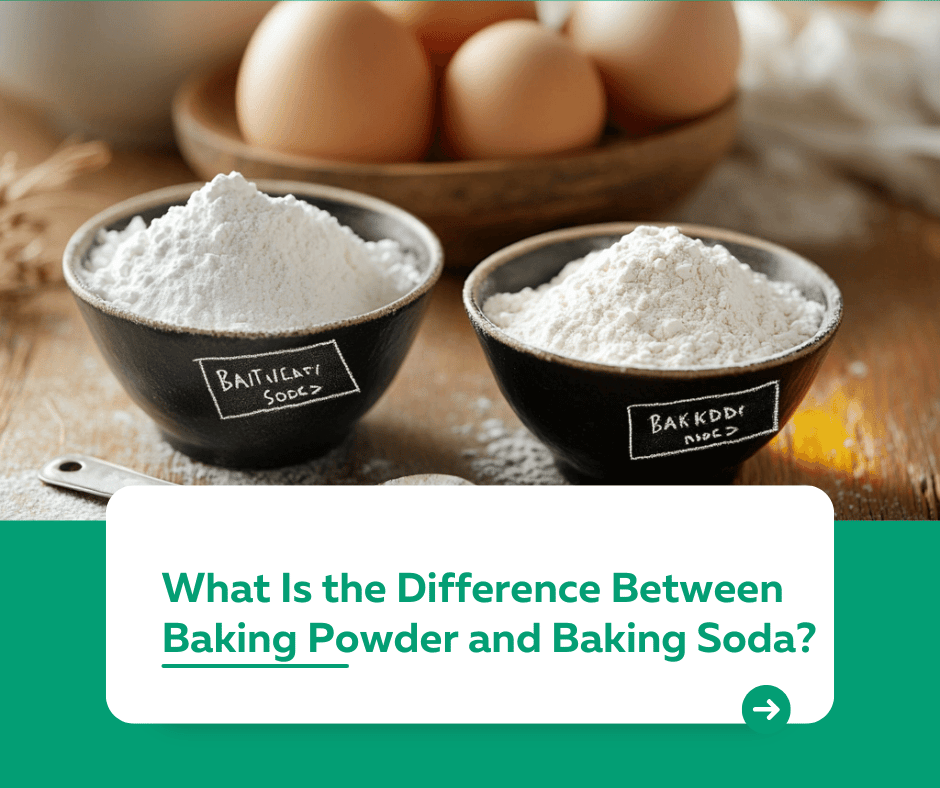
Introduction
Baking powder and baking soda are essential ingredients in baking, but they’re not interchangeable. What is the difference between baking powder and baking soda? Understanding how they work and when to use them can elevate your baking skills and ensure perfect results every time.
1. What Are Baking Powder and Baking Soda?
1.1 Baking Soda
- Chemical Composition: Pure sodium bicarbonate.
- Activation: Requires an acidic ingredient (e.g., vinegar, lemon juice, buttermilk) and moisture to create carbon dioxide bubbles, which help baked goods rise.
1.2 Baking Powder
- Chemical Composition: Contains sodium bicarbonate, an acid (usually cream of tartar), and a moisture-absorbing agent (like cornstarch).
- Activation: Double-acting baking powder reacts twice—once when mixed with wet ingredients and again when exposed to heat.
2. Key Differences Between Baking Powder and Baking Soda
2.1 Chemical Reaction
- Baking Soda: Requires an external acidic ingredient to activate.
- Baking Powder: Includes its own acid and only needs moisture and heat.
2.2 Taste
- Baking Soda: Can leave a bitter or soapy aftertaste if not neutralized by enough acid.
- Baking Powder: Has a neutral flavor and is less likely to affect the taste of the final product.
2.3 Usage in Recipes
- Baking Soda: Often used in recipes with acidic ingredients like chocolate, yogurt, or molasses.
- Baking Powder: Common in recipes without additional acids, such as cakes or pancakes.
3. When to Use Baking Powder vs. Baking Soda
3.1 Use Baking Soda If:
- The recipe includes acidic ingredients (e.g., buttermilk, lemon juice, vinegar).
- You want a stronger leavening effect for quick-rising results.
3.2 Use Baking Powder If:
- The recipe does not include acidic ingredients.
- You need a balanced rise during mixing and baking.
4. Can You Substitute Baking Powder and Baking Soda?
Substituting Baking Powder for Baking Soda
- Baking powder can replace baking soda, but you’ll need about three times the amount. Be cautious, as this may affect the taste and texture.
Substituting Baking Soda for Baking Powder
- Use 1 part baking soda with 2 parts cream of tartar to mimic baking powder.
5. Tips for Using Baking Powder and Baking Soda
1️⃣ Check Freshness: Test baking soda by adding vinegar and baking powder by adding water—bubbles mean they’re still effective.
2️⃣ Store Properly: Keep in an airtight container in a cool, dry place.
3️⃣ Follow the Recipe: Use the specified ingredient to achieve the desired flavor and texture.
Conclusion
The difference between baking powder and baking soda lies in their chemical composition and activation process. While both are leavening agents, they serve distinct purposes in baking. Understanding when and how to use each will ensure your baked goods rise to perfection. Ready to bake like a pro? For more tips, visit our Kuestion.com.